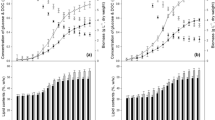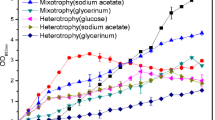Abstract
In this study, hypersaline media were used for ocean cultivation of the marine microalga Tetraselmis sp. KCTC12432BP for enhanced biomass and fatty acid (FA) productivity. Hypersaline media (55, 80, and 105 PSU) were prepared without sterilization by addition of NaCl to seawater obtained from Incheon, Korea. The highest biomass productivity was obtained at 55 PSU (0.16 g L−1 day−1) followed by 80 PSU (0.15 g L−1 day−1). Although the specific growth rate of Tetraselmis decreased at salinities higher than 55 PSU, prevention of contamination led to higher biomass productivity at 80 PSU than at 30 PSU (0.03 g L−1 day−1). FA content of algal biomass increased as salinity increased to 80 PSU, above which it declined, and FA productivity was highest at 80 PSU. Ocean cultivation of Tetraselmis was performed using 50-L tubular module photobioreactors and 2.5-kL square basic ponds, closed- and open-type ocean culture systems, respectively. Culturing microalgae in hypersaline medium (80 PSU) improved biomass productivities by 89 and 152% in closed and open cultures, respectively, compared with cultures with regular salinity. FA productivity was greatly improved by 369% in the closed cultures. The efficacy of salinity shift and N-deficiency to enhance FA productivity was also investigated. Lowering salinity to 30 PSU with N-starvation following cultivation at 80 PSU improved FA productivity by 19% in comparison with single-stage culture without N-deficiency at 30 PSU. The results show that salinity manipulation could be an effective strategy to improve biomass and FA productivity in ocean cultivation of Tetraselmis sp.







Similar content being viewed by others
References
Al-Hasan RH, Ali AM, Ka'wash HH, Radwan SS (1990) Effect of salinity on the lipid and fatty acid composition of the halophyte Navicula sp.: potential in mariculture. J Appl Phycol 2:215–222
Bartley ML, Boeing WJ, Corcoran AA, Holguin FO, Schaub T (2013) Effects of salinity on growth and lipid accumulation of biofuel microalga Nannochloropsis salina and invading organisms. Biomass Bioenergy 54:83–88
Borowitzka MA (1999) Commercial production of microalgae: ponds, tanks, tubes and fermenters. J Biotech 70:313–321
Carney LT, Reinsch SS, Lane PD, Solberg OD, Jansen LS, Williams KP, Trent JD, Lane TW (2014) Microbiome analysis of a microalgal mass culture growing in municipal wastewater in a prototype OMEGA photobioreactor. Algal Res 4:52–61
Das P, Aziz SS, Obbard JP (2011) Two phase microalgae growth in the open system for enhanced lipid productivity. Renew Energy 36:2524–2528
Fanesi A, Raven JA, Giordano M (2014) Growth rate affects the responses of the green alga Tetraselmis suecica to external perturbations. Plant Cell Environ 37:512–519
Fon-Sing S, Borowitzka MA (2016) Isolation and screening of euryhaline Tetraselmis spp. suitable for large-scale outdoor culture in hypersaline media for biofuels. J Appl Phycol 28:1–14
Fon-Sing S, Isdepsky A, Borowitzka MA, Lewis D (2014) Pilot-scale continuous recycling of growth medium for the mass culture of a halotolerant Tetraselmis sp. in raceway ponds under increasing salinity: a novel protocol for commercial microalgal biomass production. Bioresour Technol 161:47–54
Gleason FH, Karpov SA, Lilje O, Macarthur DJ, Van Otgen F, Sime-Ngando T (2014) Zoosporic parasites of phytoplankton. In: Gareth Jones EB, Hyde KD, Pang K-L (eds) Freshwater fungi and fungal-like organisms, Walter de Gruyter, Berlin, pp 279-304
Gu N, Lin Q, Li G, Tan Y, Huang L, Lin J (2012) Effect of salinity on growth, biochemical composition, and lipid productivity of Nannochloropsis oculata CS 179. Eng Life Sci 12:631–637
Hagemann M (2016) Coping with high and variable salinity: molecular aspects of compatible solute accumulation. In: Borowitzka MA, Beardall J, Raven JA (eds) The physiology of microalgae. Springer, Cham, pp 359-372.
Hellebust JA (1985) Mechanisms of response to salinity in halotolerant microalgae. Plant Soil 89:69–81
Ho S-H, Nakanishi A, Ye X, Chang J-S, Hara K, Hasunuma T, Kondo A (2014) Optimizing biodiesel production in marine Chlamydomonas sp. JSC4 through metabolic profiling and an innovative salinity-gradient strategy. Biotechnol Biofuels 7:97
Hoffman Y, Aflalo C, Zarka A, Gutman J, James TY, Boussiba S (2008) Isolation and characterization of a novel chytrid species (phylum Blastocladiomycota), parasitic on the green alga Haematococcus. Mycol Res 112:70–81
Karpov SA, Mamkaeva MA, Benzerara K, Moreira D, López-García P (2014) Molecular phylogeny and ultrastructure of Aphelidium aff. melosirae (Aphelida, Opisthosporidia). Protist 165:512–526
Khatoon H, Rahman NA, Banerjee S, Harun N, Suleiman SS, Zakaria NH, Lananan F, Hamid SHA, Endut A (2014) Effects of different salinities and pH on the growth and proximate composition of Nannochloropsis sp. and Tetraselmis sp. isolated from South China Sea cultured under control and natural condition. Int Biodeterior Biodegrad 95:11–18
Kim G, Lee C-H, Lee K (2016a) Enhancement of lipid production in marine microalga Tetraselmis sp. through salinity variation. Korean J Chem Eng 33:230–237
Kim Z-H, Park H, Hong S-J, Lim S-M, Lee C-G (2016b) Development of a floating photobioreactor with internal partitions for efficient utilization of ocean wave into improved mass transfer and algal culture mixing. Bioprocess Biosyst Eng 39:713–723
Kim Z-H, Park H, Lee C-G (2016c) Seasonal assessment of biomass and fatty acid productivity by Tetraselmis sp. in the ocean using semi-permeable membrane photobioreactors. J Microbiol Biotechnol 26:1098–1102
Kim Z-H, Park H, Lee H-S, Lee C-G (2016d) Enhancing photon utilization efficiency for astaxanthin production from Haematococcus lacustris using a split-column photobioreactor. J Microbiol Biotechnol 26:1285–1289
Kim Z-H, Park H, Ryu Y-J, Shin D-W, Hong S-J, Tran H-L, Lim S-M, Lee C-G (2015) Algal biomass and biodiesel production by utilizing the nutrients dissolved in seawater using semi-permeable membrane photobioreactors. J Appl Phycol 27:1763–1773
Klok AJ, Lamers PP, Martens DE, Draaisma RB, Wijffels RH (2014) Edible oils from microalgae: insights in TAG accumulation. Trends Biotechnol 32:521–528
Moheimani NR (2013) Inorganic carbon and pH effect on growth and lipid productivity of Tetraselmis suecica and Chlorella sp (Chlorophyta) grown outdoors in bag photobioreactors. J Appl Phycol 25:387–398
Norsker N-H, Barbosa MJ, Vermuë MH, Wijffels RH (2011) Microalgal production—a close look at the economics. Biotechnol Adv 29:24–27
Novoveská L, Zapata AKM, Zabolotney JB, Atwood MC, Sundstrom ER (2016) Optimizing microalgae cultivation and wastewater treatment in large-scale offshore photobioreactors. Algal Res 18:86–94
Park H, Lee C-G (2016) Theoretical calculations on the feasibility of microalgal biofuels: utilization of marine resources could help realizing the potential of microalgae. Biotechnol J 11:1461–1470
Pretorius J, Engelbrecht AHP (1980) The occurrence of a fungal parasite on a Tetraselmis (Prasinophyceae) species. Water SA 6:181–185
Renaud SM, Parry DL (1994) Microalgae for use in tropical aquaculture II: effect of salinity on growth, gross chemical composition and fatty acid composition of three species of marine microalgae. J Appl Phycol 6:347–356
Richardson JW, Johnson MD, Zhang X, Zemke P, Chen W, Hu Q (2014) A financial assessment of two alternative cultivation systems and their contributions to algae biofuel economic viability. Algal Res 4:96–104
Rodolfi L, Chini Zittelli G, Bassi N, Padovani G, Biondi N, Bonini G, Tredici MR (2009) Microalgae for oil: strain selection, induction of lipid synthesis and outdoor mass cultivation in a low-cost photobioreactor. Biotechnol Bioeng 102:100–112
Saadaoui I, Al Ghazal G, Bounnit T, Al Khulaifi F, Al Jabri H, Potts M (2016) Evidence of thermo and halotolerant Nannochloris isolate suitable for biodiesel production in Qatar Culture Collection of Cyanobacteria and Microalgae. Algal Res 14:39–47
Su C-H, Chien L-J, Gomes J, Lin Y-S, Yu Y-K, Liou J-S, Syu R-J (2011) Factors affecting lipid accumulation by Nannochloropsis oculata in a two-stage cultivation process. J Appl Phycol 23:903–908
Suh IS, Joo H-N, Lee C-G (2006) A novel double-layered photobioreactor for simultaneous Haematococcus pluvialis cell growth and astaxanthin accumulation. J Biotech 125:540–546
Takagi M, Karseno YT (2006) Effect of salt concentration on intracellular accumulation of lipids and triacylglyceride in marine microalgae Dunaliella cells. J Biosci Bioeng 101:223–226
Tran H-L, Hong S-J, Lee C-G (2009) Evaluation of extraction methods for recovery of fatty acids from Botryococcus braunii LB 572 and Synechocystis sp. PCC 6803. Biotechnol Bioprocess Eng 14:187–192
Wang D, Wang W, Xu N, Sun X (2016) Changes in growth, carbon and nitrogen enzyme activity and mRNA accumulation in the halophilic microalga Dunaliella viridis in response to NaCl stress. J Ocean Univ China 15:1094–1100
Wiley P, Harris L, Reinsch S, Tozzi S, Embaye T, Clark K, McKuin B, Kolber Z, Adams R, Kagawa H (2013) Microalgae cultivation using offshore membrane enclosures for growing algae (OMEGA). J Sust Bioenergy Syst 3:18–32
Xia L, Ge H, Zhou X, Zhang D, Hu C (2013) Photoautotrophic outdoor two-stage cultivation for oleaginous microalgae Scenedesmus obtusus XJ-15. Bioresour Technol 144:261–267
Zakhozhii I, Matalin D, Popova L, Balnokin YV (2012) Responses of photosynthetic apparatus of the halotolerant microalga Dunalliella maritima to hyperosmotic salt shock. Russ J Plant Physiol 59:42–49
Zeng M-T, Vonshak A (1998) Adaptation of Spirulina platensis to salinity-stress. Comp Biochem Physiol A 120:113–118
Funding
This research was supported by a grant from the Marine Biotechnology Program (Project No.: 20090267, Development of Marine Microalgal Biofuel Production Technology) funded by the Ministry of Oceans and Fisheries, Korea. Authors are also grateful to the Manpower Development Program for Marine Energy from the same ministry (Project No.: 201405502). Hanwool Park was also supported by a NRF (National Research Foundation of Korea) Grant funded by the Korean Government (NRF-2013H1A2A1032623).
Author information
Authors and Affiliations
Corresponding author
Rights and permissions
About this article
Cite this article
Park, H., Jung, D., Lee, J. et al. Improvement of biomass and fatty acid productivity in ocean cultivation of Tetraselmis sp. using hypersaline medium. J Appl Phycol 30, 2725–2735 (2018). https://doi.org/10.1007/s10811-018-1388-3
Received:
Revised:
Accepted:
Published:
Issue Date:
DOI: https://doi.org/10.1007/s10811-018-1388-3




